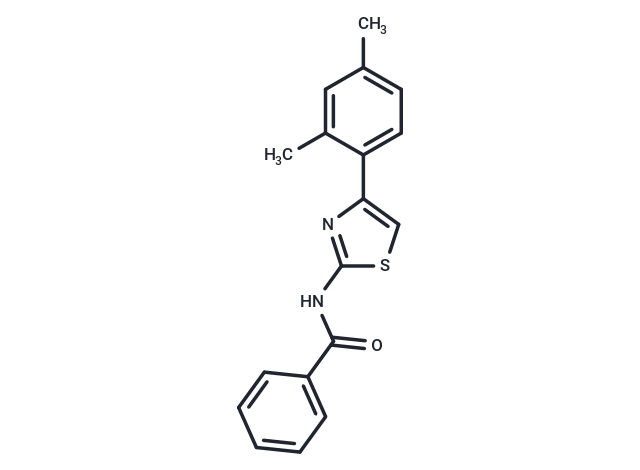Shopping Cart
- Remove All
 Your shopping cart is currently empty
Your shopping cart is currently empty
INH1 (IBT13131) is a cell-permeable Hec1 inhibitor that specifically disrupts the Hec1/Nek2 interaction.

| Pack Size | Price | Availability | Quantity |
|---|---|---|---|
| 25 mg | $48 | In Stock | |
| 50 mg | $88 | In Stock | |
| 100 mg | $143 | In Stock | |
| 200 mg | $212 | In Stock | |
| 1 mL x 10 mM (in DMSO) | $29 | In Stock |
| Description | INH1 (IBT13131) is a cell-permeable Hec1 inhibitor that specifically disrupts the Hec1/Nek2 interaction. |
| Targets&IC50 | Hec1:10-21 μM |
| In vitro | Intraperitoneal injection of 100 mg/kg INH1 inhibits the growth of mammary tumors in mice with MDA-MB-468 human breast cancer xenografts. |
| In vivo | INH1 effectively inhibits the proliferation of human breast cancer cells with a GI50 of 10-21 μM. Additionally, INH1 induces cell-killing activity by disrupting the spindle checkpoint-regulated Hec1/Nek2 pathway. |
| Kinase Assay | Binding assays: Surface plasma resonance (SPR) assays are performed at 22.5°C in HBSD buffer [10 mmol/L HEPES, 150 mmol/L NaCl, 0.1% DMSO (pH 7.5)] on Biacore 3000. 6×His-Hec1 and GST-Nek2 are purified. NTA sensor chip or glutathione-modified CM5 chip are used to capture His-Hec1 and GST-Nek2, respectively. The capture level is about 140 to 180 resonance units (RU) at the flow rate of 5 μL/min. For the binding assay, chips are sequentially treated with compounds (1 or 20 μmol/L) and then proteins (50 μg/mL). Retained RUs are recorded and processed (triplicate experiments). |
| Cell Research | Standard 3-(4,5-dimethylthiazol-2-yl)-2,5-diphenyltetrazolium bromide assays with a 3-d drug treatment procedure are performed to measure the dose-dependent cytotoxicity of INH1 in cultured cells. Triplicate sets are measured and compiled for final data presentation.(Only for Reference) |
| Synonyms | IBT13131 |
| Molecular Weight | 308.4 |
| Formula | C18H16N2OS |
| Cas No. | 313553-47-8 |
| Smiles | Cc1ccc(-c2csc(NC(=O)c3ccccc3)n2)c(C)c1 |
| Relative Density. | 1.239 g/cm3 at 20℃ |
| Storage | Powder: -20°C for 3 years | In solvent: -80°C for 1 year | Shipping with blue ice/Shipping at ambient temperature. | |||||||||||||||||||||||||||||||||||
| Solubility Information | DMSO: 30.8 mg/mL (99.87 mM), Sonication is recommended. Ethanol: 3.1 mg/mL (10.05 mM), Sonication is recommended. | |||||||||||||||||||||||||||||||||||
Solution Preparation Table | ||||||||||||||||||||||||||||||||||||
Ethanol/DMSO
DMSO
| ||||||||||||||||||||||||||||||||||||

Copyright © 2015-2025 TargetMol Chemicals Inc. All Rights Reserved.